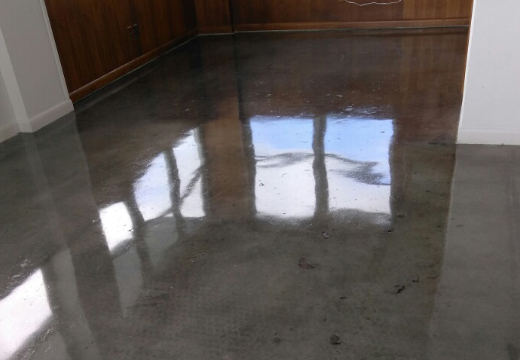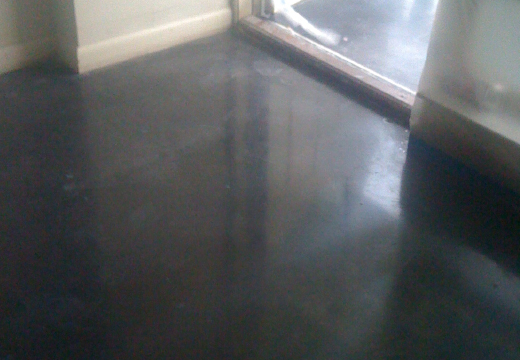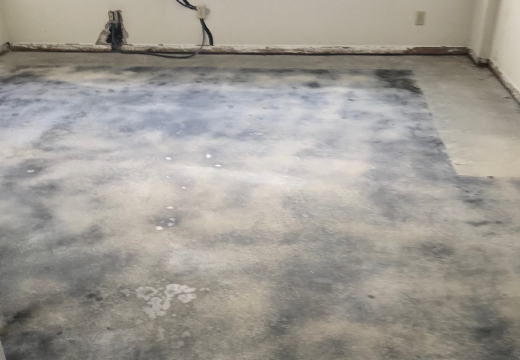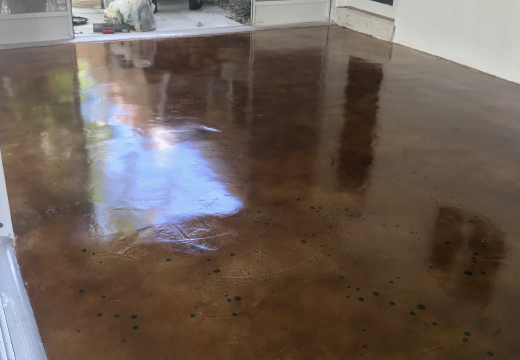Concrete Floor Staining Service

Concrete Floor Staining is widely used to color the concrete especially in a new pour or other applications, such as micro topping to give old, pitted concrete a fresh new surface to add color to for a smooth finish. Staining is just one form of decorative concrete. Concrete stain is a water based stain that will be put onto the concrete and the color pigment will be absorbed into the pours of the concrete to achieved the color wanted for the concrete surface. The color effects with this tend to be more opaque and more uniform however offer an almost infinite array of color choices, allowing you to customize your home to your particular specification.
Concrete floor repair can be used for, among other things, walls, floors and counter tops that are structurally sound and also provide a decorative finish that resembles polished stone, with less cost for materials. Decorative concrete involves using concrete in roles that are not strictly related to it’s functional elements. Concrete is widely used because of its great strength and now is even used a cost effitive way to do counter tops.
Staining concrete floors is an especially creative way to benefit from the durability and decorative possibilities of this material, using new techniques on a surface that has been used for your homes foundation floors.
Concrete Acid Staining
There are a huge number of decorative concrete applications. They include custom chemical staining (acid staining), decorative scoring, dying and many personal touches. Chemical staining and dying creates a one-of-a-kind floor that cannot be duplicated because each concrete floor will accept stains differently. Each floor is made of a different concrete/stone mix, different aggregate, and differing previous use. These color stains and dyes react with the surface and penetrate — they ARE NOT paints or coatings. When using a acid stain, your floor will be unique, with a variegated look, somewhat marble like. After the acid stain has dried, it will then be coated with a sealer to protect the surface. Leaving the concrete with a beautiful color and shine with minimal maintenance.
Unfortunately, floors that are wavy, need extensive patching, or are extremely porous may not respond well to marble floor polishing. Our experienced sales staff will be able to advise you.For a totally smooth monolithic concrete floor (one without the typical concrete “character”) a concrete overlay can be applied. This concrete overlay will also accept stains and dyes and can be polished to a high shine or left at a matte finish.
Our Service

Concrete Floor Polishing
When you think of concrete floors, you must have in your mind some industrial areas and large warehouses. But concrete floors are becoming popular in loft apartments, studios, and condo units, though not the dull-looking unpolished concrete floors you have in mind…

Concrete Floor Repair
If you are tired of looking at your gray concrete floor which you keep covering with rugs and mats, then perhaps it is time for staining and does not really need absolute concrete floor repair. It’s an easy do-it-yourself job, but then it also involves substances…

Concrete Floor Care
A concrete floor no longer has to be the dusty, dull surface it once was. COLONIAL FLOOR AND STONE CARE in Ft. Lauderdale can transform your concrete into as sophisticated a surface as the finest marble, using the most advanced polishing and densifying systems…
Our Service Area
Miami-Dade County
Surfside, Biscayne Park, El Portal, North Bay Village, Miami Springs, Hialeah Gardens, Bay Harbor Islands, Cutler Bay, Palmetto Bay Miami Shores and Miami Florida,Miami Beach, Coral Gables, Hialeah, North Miami, North Miami Beach, Miami lakes, Key Biscayne, Pinecrest and Miami areas
Palm Beach County
Boca Raton, Lake Worth, Boynton Beach, Wellington, Jupiter, Palm Beach Gardens, Greenacres, Royal Palm Beach and West Palm Beach, South Palm Beach, Ocean Ridge, Tequesta, Juno Beach, Lantana, Rivera Beach, Delray Beach, Wellington, Jupiter, Palm Beach Florida
Broward County
Hollywood Florida, Pompano Beach, Plantation, Davie, Coral Springs, Deerfield Beach, Coral Springs, Miramar, Westin, Hallandale Beach, Coconut Creek, Dania Beach, Oakland Park, Cooper City, Lauderdale By The Sea, Lighthouse Pointe, Southwest Ranches, Sea Ranch Lakes, Hollywood, Wilton Manors, Fort Lauderdale
Concrete Floor Staining FAQ
How to Fix Stained Concrete Floors?
To fix stained concrete floors, first identify the cause of the stain and clean the surface thoroughly. Then, use a concrete stain remover or a solution of water and a mild detergent to remove the stain. If necessary, use a concrete resurfacer or patching compound to repair any surface damage. After repair, polish the surface using a concrete grinder with progressively finer diamond abrasive pads. Finally, apply a concrete sealer to protect the floor from moisture and stains. Fixing stained concrete floors can improve its appearance, durability, and make it easier to maintain.
Is It Better to Stain or Paint Concrete Floors?
Staining concrete floors can enhance the natural look of the concrete and provide a unique, long-lasting finish. On the other hand, painting concrete floors can provide a solid, opaque color that covers any existing surface imperfections. Both options have their pros and cons and the best choice depends on the desired look and functionality. Stains can be more expensive and time-consuming to apply, while paint is easier to apply and can be less expensive. Both options require proper surface preparation and maintenance.
How to Remove Stains from Polished Concrete Floors?
To remove stains from polished concrete floors, first identify the type of stain and its source. Then, use a concrete stain remover or a solution of water and a mild detergent to clean the surface. For stubborn stains, consider using a pressure washer or a floor grinder with a diamond abrasive pad. Avoid using acidic or caustic cleaning products, as they can damage the polished surface. After removing the stain, rinse the surface thoroughly and allow it to dry completely. To maintain the polished surface, apply a concrete sealer to protect it from moisture and future stains.
How to Remove Oil Stains from Concrete Garage Floor?
To remove oil stains from a concrete garage floor, start by cleaning the surface with a degreaser or a solution of water and a mild detergent. If the stain is still present, use a concrete stain remover specifically designed for oil stains. For stubborn stains, consider using a floor grinder with a diamond abrasive pad. After removing the stain, rinse the surface thoroughly and allow it to dry completely. To maintain the surface, consider applying a concrete sealer to protect it from moisture and future stains. Remember that the earlier you address an oil stain, the easier it will be to remove.
How to Clean Stained Concrete Floors?
To clean stained concrete floors, first sweep or vacuum the surface to remove any loose debris. Then, use a solution of water and a mild detergent or a concrete cleaner specifically designed for stained concrete. Avoid using acidic or caustic cleaning products, as they can damage the stained surface. For stubborn stains, consider using a pressure washer or a floor grinder with a diamond abrasive pad. After cleaning, rinse the surface thoroughly and allow it to dry completely. To maintain the stained surface, consider applying a concrete sealer to protect it from moisture and future stains. Regular cleaning can help keep stained concrete floors looking their best.
Who Stains Concrete Floors?
At Colonial Floor and Stone Care, we specialize in staining concrete floors. Our team of skilled technicians have years of experience and use high-quality products and equipment to provide a unique, long-lasting finish for residential and commercial concrete surfaces. From surface preparation to final sealing, we handle every aspect of the staining process to ensure a high-quality result. Our goal is to enhance the natural beauty of concrete floors and provide a durable and low-maintenance finish that our clients can enjoy for years to come.
